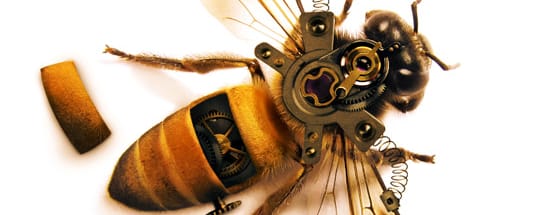Creating a Highly Detailed Steampunk Insect
In this tutorial I'm going to walk through my process for creating a photo-realistic steampunk style insect. This tutorial involves a lot of image composites, so rather than repeating instructions over and over, I'm going to walk through the steps I took and give you an overview of my ideas and thought process behind the piece. This tutorial is surprisingly easy, you just need to have a basic understanding of selection and blending techniques in Photoshop to make the final image appear as realistic as possible. In this article, I'm assuming that you have a moderate understanding of the techniques I'm using, as I don't go into great detail on every step. Lets take a look.
Here is a view of what we will be creating.
 Typically with projects like these I will gather a group of photos that I think might work in the composition, and as I work I begin to narrow down what photos will and will not work. My final list of photos consisted of these:
- Honey Bee Macro (incredible photo!)
- Spring/Coil Image
- Clock Mechanism
- Skeleton Caseback
Typically with projects like these I will gather a group of photos that I think might work in the composition, and as I work I begin to narrow down what photos will and will not work. My final list of photos consisted of these:
- Honey Bee Macro (incredible photo!)
- Spring/Coil Image
- Clock Mechanism
- Skeleton Caseback
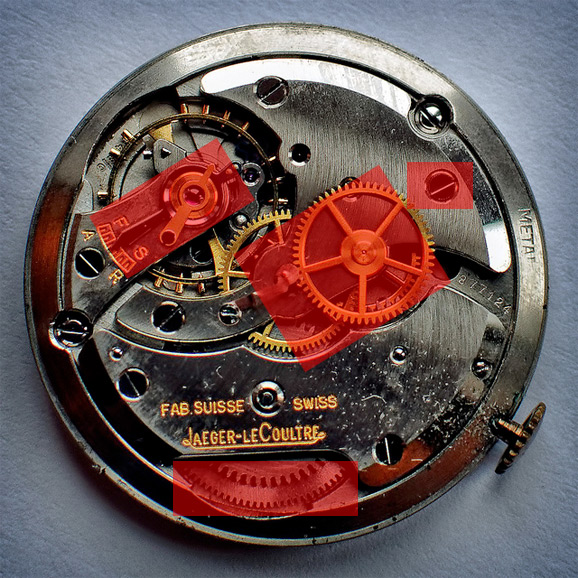
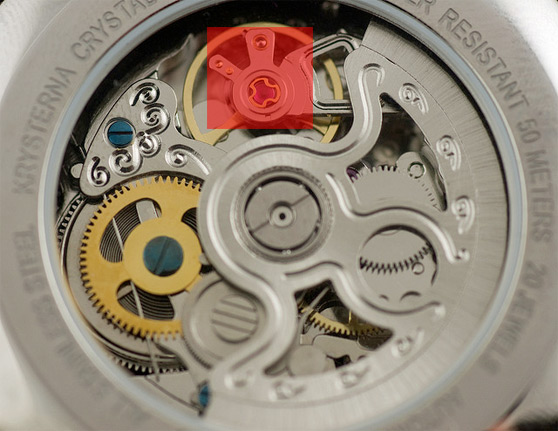 I used the Quick Mask Mode (Q) to extract these pieces, but you can use whatever selection method that you prefer.
I used the Quick Mask Mode (Q) to extract these pieces, but you can use whatever selection method that you prefer.
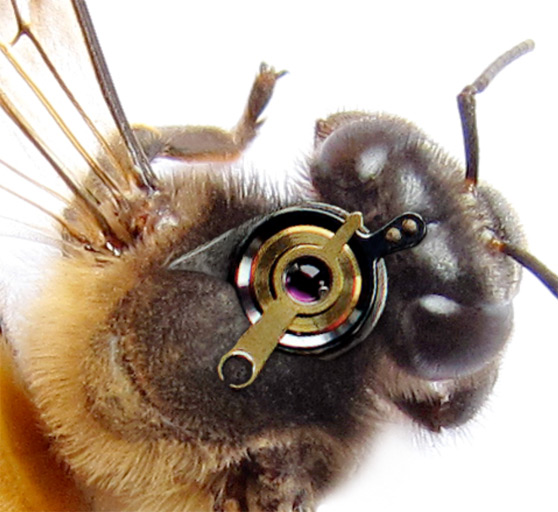 I added the first piece, and positioned it in a way that I felt it looked natural. I decided this seemed like a starting point that I could build onto with other mechanical parts.
I added the first piece, and positioned it in a way that I felt it looked natural. I decided this seemed like a starting point that I could build onto with other mechanical parts.
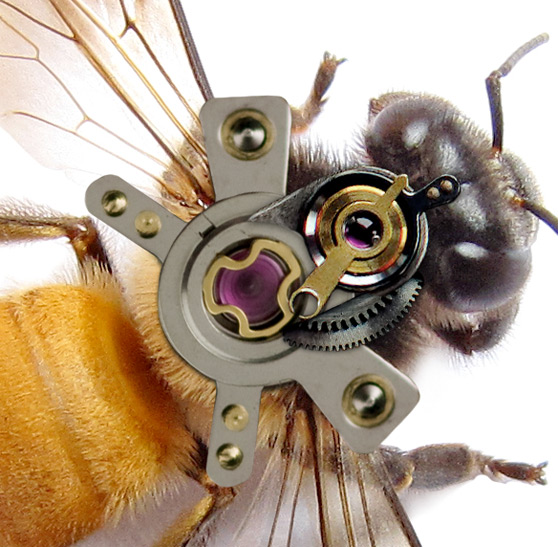 From there I began adding other pieces, and positioned them like puzzle pieces. "This fits here. That fits there... etc". As I was positioning the mechanical parts I realized that the arms sticking out sort of aligned with the bee's wings, so I knew I wanted to accent that a little more. In comes the coil springs. I used the Puppet Warp Tool to bend the springs in the direction I wanted. If you've never used the Puppet Warp Tool
From there I began adding other pieces, and positioned them like puzzle pieces. "This fits here. That fits there... etc". As I was positioning the mechanical parts I realized that the arms sticking out sort of aligned with the bee's wings, so I knew I wanted to accent that a little more. In comes the coil springs. I used the Puppet Warp Tool to bend the springs in the direction I wanted. If you've never used the Puppet Warp Tool
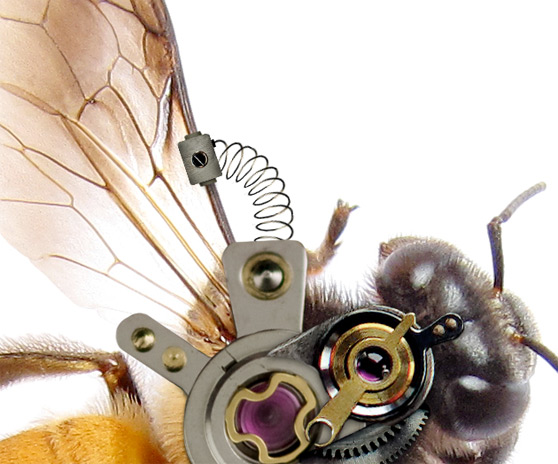 I felt like the metal on the arms was a little too clean compared to the first piece. So decided to overlay a texture just on that layer. Any good metal grunge texture will work well.
I felt like the metal on the arms was a little too clean compared to the first piece. So decided to overlay a texture just on that layer. Any good metal grunge texture will work well.
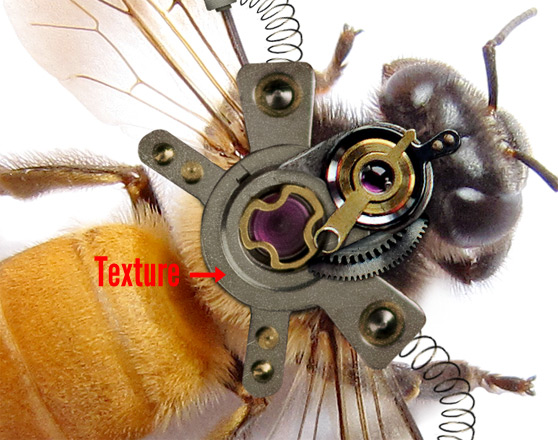 Next up, I painted some subtle shadows using a soft black brush at 30% opacity. The idea is to start light and build up the shadows.
Next up, I painted some subtle shadows using a soft black brush at 30% opacity. The idea is to start light and build up the shadows.
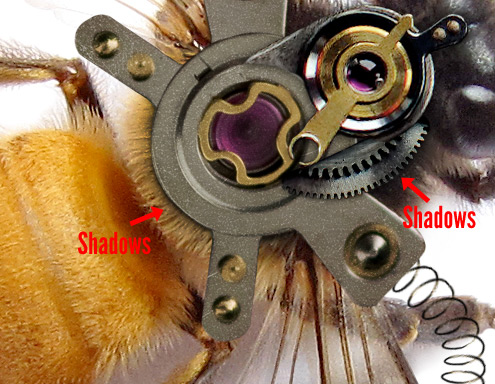
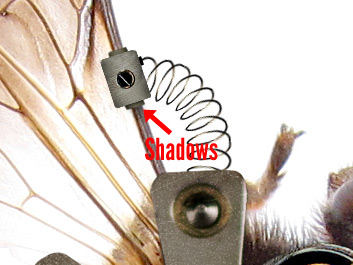
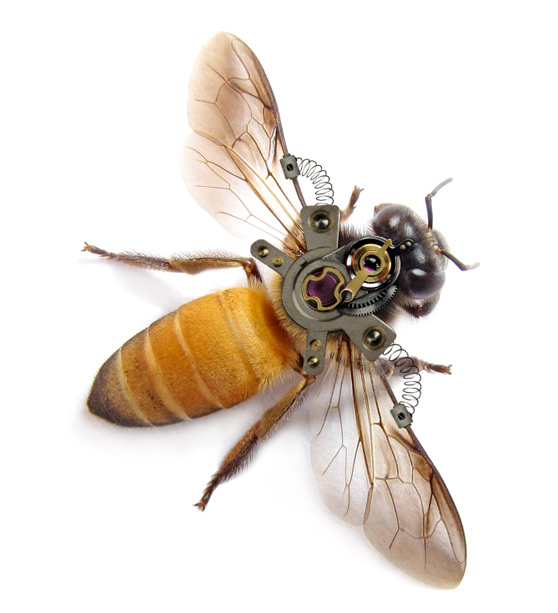 Looking at the clock gear images, I decided it might be cool if there was a little hatch or opening in the bee where the viewer could get a glimpse at some of the inner mechanisms of the bee. In order to do that I made a vector shape in the spot I felt the hatch should appear.
Looking at the clock gear images, I decided it might be cool if there was a little hatch or opening in the bee where the viewer could get a glimpse at some of the inner mechanisms of the bee. In order to do that I made a vector shape in the spot I felt the hatch should appear.
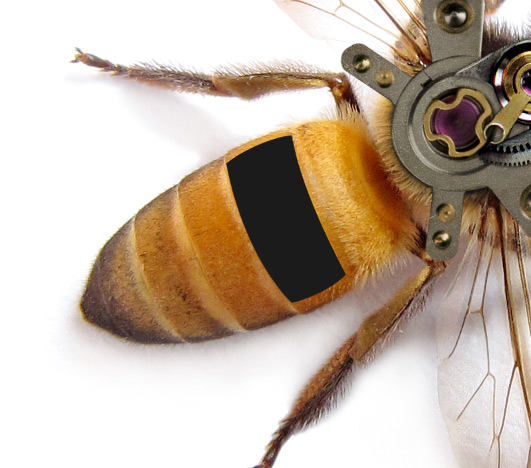 I made a selection using this shape and copied and pasted the bee's back to make a separate hatch piece laying off to the side. I used the distort transform tool (Edit | Transform | Distort) to warp the hatch slightly so that the angle looked natural. Then I painted some shadows on a layer underneath.
I made a selection using this shape and copied and pasted the bee's back to make a separate hatch piece laying off to the side. I used the distort transform tool (Edit | Transform | Distort) to warp the hatch slightly so that the angle looked natural. Then I painted some shadows on a layer underneath.
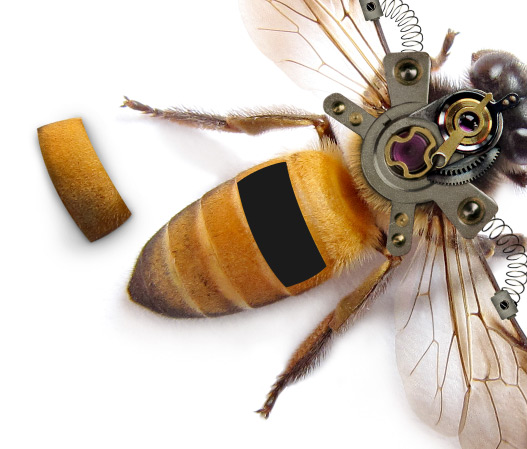 As for the exposed mechanisms inside the view port, I coped and pasted another section of the clock gears, and used the vector shape as a guide to remove the portions I didn't want.
As for the exposed mechanisms inside the view port, I coped and pasted another section of the clock gears, and used the vector shape as a guide to remove the portions I didn't want.
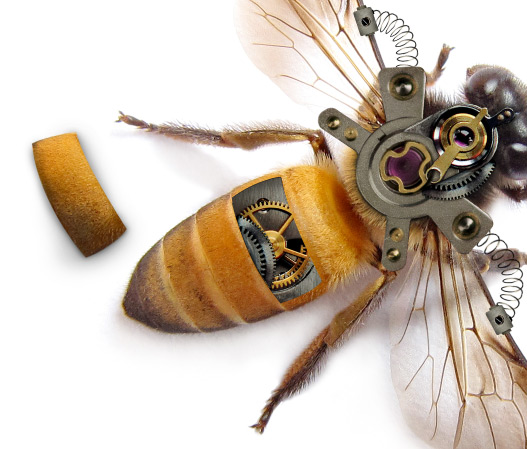 Now it's just a matter of shading the area to look a bit more natural. I used the soft black brush at 30% again.
Now it's just a matter of shading the area to look a bit more natural. I used the soft black brush at 30% again.
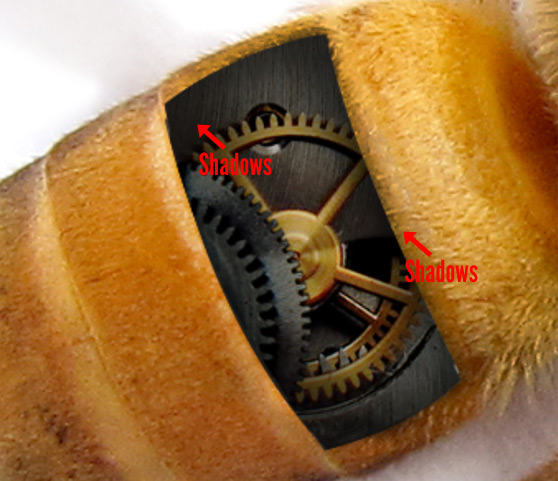
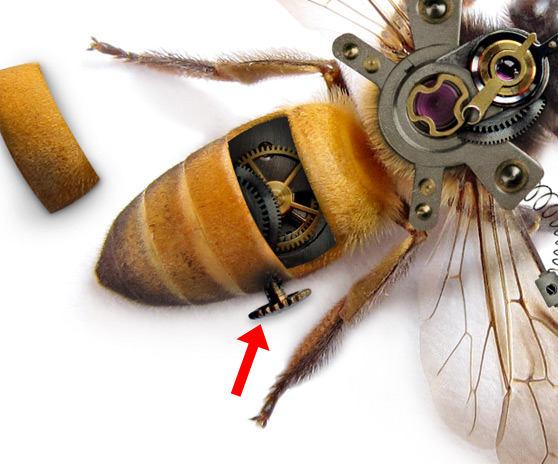
 Below is the final piece.
Below is the final piece.
 I hope this overview has given you an idea of my thought process as I worked through this piece, and some of the ideas that I applied while designing. Gather some photos up and give it a try. Steampunk styled compositions can be incredibly detailed and a lot of fun to build.
I hope this overview has given you an idea of my thought process as I worked through this piece, and some of the ideas that I applied while designing. Gather some photos up and give it a try. Steampunk styled compositions can be incredibly detailed and a lot of fun to build.
 Typically with projects like these I will gather a group of photos that I think might work in the composition, and as I work I begin to narrow down what photos will and will not work. My final list of photos consisted of these:
- Honey Bee Macro (incredible photo!)
- Spring/Coil Image
- Clock Mechanism
- Skeleton Caseback
Typically with projects like these I will gather a group of photos that I think might work in the composition, and as I work I begin to narrow down what photos will and will not work. My final list of photos consisted of these:
- Honey Bee Macro (incredible photo!)
- Spring/Coil Image
- Clock Mechanism
- Skeleton Caseback
Step 1 - Deciding What Clock Gears to Use
I think the hardest part of building a composition like this is deciding what pieces to extract and composite into the the piece. In this image it was a matter of what gears and pieces would work on the bee's body, and which of those pieces would fit well together and look like something someone would actually build. On the two clock gear images I used the following pieces.
 I used the Quick Mask Mode (Q) to extract these pieces, but you can use whatever selection method that you prefer.
I used the Quick Mask Mode (Q) to extract these pieces, but you can use whatever selection method that you prefer.
Step 2 - Adding the Extracted Images to the Main Composition
This is where the blending and color matching comes into play. The idea is to make these pieces look as natural as possible in the composition, so that your eye does not get automatically drawn to an area that looks distracting or unnatural. To start, I created a new document 1500x1500 at 72 dpi, and pasted the bee image onto it. I added the first piece, and positioned it in a way that I felt it looked natural. I decided this seemed like a starting point that I could build onto with other mechanical parts.
I added the first piece, and positioned it in a way that I felt it looked natural. I decided this seemed like a starting point that I could build onto with other mechanical parts.
 From there I began adding other pieces, and positioned them like puzzle pieces. "This fits here. That fits there... etc". As I was positioning the mechanical parts I realized that the arms sticking out sort of aligned with the bee's wings, so I knew I wanted to accent that a little more. In comes the coil springs. I used the Puppet Warp Tool to bend the springs in the direction I wanted. If you've never used the Puppet Warp Tool
From there I began adding other pieces, and positioned them like puzzle pieces. "This fits here. That fits there... etc". As I was positioning the mechanical parts I realized that the arms sticking out sort of aligned with the bee's wings, so I knew I wanted to accent that a little more. In comes the coil springs. I used the Puppet Warp Tool to bend the springs in the direction I wanted. If you've never used the Puppet Warp Tool
 I felt like the metal on the arms was a little too clean compared to the first piece. So decided to overlay a texture just on that layer. Any good metal grunge texture will work well.
I felt like the metal on the arms was a little too clean compared to the first piece. So decided to overlay a texture just on that layer. Any good metal grunge texture will work well.
 Next up, I painted some subtle shadows using a soft black brush at 30% opacity. The idea is to start light and build up the shadows.
Next up, I painted some subtle shadows using a soft black brush at 30% opacity. The idea is to start light and build up the shadows.


Step 3 - More Detail
I like how this is looking so far. But I feel like something more is needed. Looking at the clock gear images, I decided it might be cool if there was a little hatch or opening in the bee where the viewer could get a glimpse at some of the inner mechanisms of the bee. In order to do that I made a vector shape in the spot I felt the hatch should appear.
Looking at the clock gear images, I decided it might be cool if there was a little hatch or opening in the bee where the viewer could get a glimpse at some of the inner mechanisms of the bee. In order to do that I made a vector shape in the spot I felt the hatch should appear.
 I made a selection using this shape and copied and pasted the bee's back to make a separate hatch piece laying off to the side. I used the distort transform tool (Edit | Transform | Distort) to warp the hatch slightly so that the angle looked natural. Then I painted some shadows on a layer underneath.
I made a selection using this shape and copied and pasted the bee's back to make a separate hatch piece laying off to the side. I used the distort transform tool (Edit | Transform | Distort) to warp the hatch slightly so that the angle looked natural. Then I painted some shadows on a layer underneath.
 As for the exposed mechanisms inside the view port, I coped and pasted another section of the clock gears, and used the vector shape as a guide to remove the portions I didn't want.
As for the exposed mechanisms inside the view port, I coped and pasted another section of the clock gears, and used the vector shape as a guide to remove the portions I didn't want.
 Now it's just a matter of shading the area to look a bit more natural. I used the soft black brush at 30% again.
Now it's just a matter of shading the area to look a bit more natural. I used the soft black brush at 30% again.

Step 4 - Final Tweak
Before calling it complete, I noticed that one of the gear images has a small dial. So I decide that I have to use it somewhere. After a bit of trial and error, I decide to simply place on the side of the bee next to the exposed hatch.
Step 5 - Adjusting the Final Lighting
To blend the colors and light a little better, I added a Gradient Map adjustment layer. I set the layer's blend mode to opacity, and used the following gradient. Below is the final piece.
Below is the final piece.
 I hope this overview has given you an idea of my thought process as I worked through this piece, and some of the ideas that I applied while designing. Gather some photos up and give it a try. Steampunk styled compositions can be incredibly detailed and a lot of fun to build.
I hope this overview has given you an idea of my thought process as I worked through this piece, and some of the ideas that I applied while designing. Gather some photos up and give it a try. Steampunk styled compositions can be incredibly detailed and a lot of fun to build.
